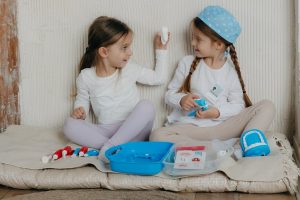Effective Ways of Cleaning Up Bloodborne Pathogens And Bodily Fluids

A fair share of incidents have been seen involving bloodborne pathogens and bodily fluids, especially when working in high-risk areas. These situations require immediate attention due to their risks to human health and safety.
Understanding how to effectively clean up these hazardous substances is crucial in preventing infection or disease transmission. It’s among the reasons why Bloodborne Pathogens training is needed in every industry.
This article discusses practical ways to safely remove bloodborne pathogens and bodily fluids from various surfaces while minimizing exposure risk. Let’s dive into the techniques and tools necessary for thorough cleanup while keeping everyone safe from potential harm.
Tips for Cleaning Up BBP and Bodily Fluids
Perhaps you’ve already had your Bloodborne Pathogens training. Here are some tips you need to know when cleaning BBP and bodily fluids.
Blood Spills Outdoors
Outdoor environments can be unpredictable and pose unique challenges in containing and cleaning up spilled blood or other bodily fluids. It is crucial to act quickly and efficiently to minimize the risk of exposure to bloodborne pathogens.
To effectively clean up outdoor blood spills, it’s essential to establish a safe perimeter around the spill site using barriers like cones or caution tape. This will help keep bystanders away from potential hazards while you work on containment and cleanup measures.
Next, don appropriate personal protective equipment (PPE), including gloves, eye protection, masks, gowns or coveralls, and shoe covers. Use absorbent materials such as paper towels or an approved commercial absorbent product to soak up any excess fluid before applying a disinfectant solution designed to kill bloodborne pathogens like HIV, Hepatitis B/C viruses.
Allow sufficient contact time according to manufacturer instructions before removing soaked materials for proper disposal by local regulations.
Blood Spills On Clothes
Bloodstains on clothes can be a messy dilemma, not just for the appearance of your garments but also due to the potential health risks involved. Therefore, knowing how to remove these stains while ensuring safety against infections efficiently is crucial.
To begin with, always wear disposable gloves when handling clothing with blood spills. Avoid direct contact with the affected area as much as possible, and try not to spread the stain further onto other parts of the fabric or surrounding surfaces.
Rinse out fresh bloodstains using cold water; this helps prevent them from setting into the fibers.
For dried bloodstains, soak the garment in cold water with an enzyme-based laundry detergent to break down protein-based substances like blood.
After soaking for about 30 minutes (or longer if needed), wash the clothing separately from other items using hot water and regular laundry detergent—Remember again to use gloves when handling contaminated materials during this process.
Once clean and dry, scrutinize the clothing item for any remaining traces of blood before wearing or storing it away. If necessary, repeat the steps mentioned above until no visible signs remain after washing and drying thoroughly at high heat settings—which will help kill off any lingering pathogens within fabrics’ pores effectively without causing damage through excessive moisture exposure over time.
Blood Spills On Carpeted Floors
Blood spills can quickly seep into carpets and upholstery, making them much harder to clean than non-porous surfaces like tile or linoleum. Nevertheless, with prompt action and appropriate measures, you can effectively mitigate the impact of these biohazardous materials.
Firstly, don personal protective equipment (PPE), including gloves, goggles, and a face mask, before attempting any cleanup. Begin by absorbing as much spilled fluid as possible using paper towels or other disposable absorbent material.
Carefully blot the spill without rubbing, which may further spread the contamination.Once you have removed most of the liquid substances from the carpet surface, apply a disinfectant solution specifically designed for dealing with bloodborne pathogens; hydrogen peroxide-based cleaners are particularly effective in breaking down blood proteins.
Let the disinfectant sit for at least 10 minutes to neutralize all pathogens. Afterward, gently scrub the area with a brush while wearing PPE until no signs of staining remain. Clean up any remaining debris and dispose of all contaminated materials according to local regulations.
It’s essential not only to tend to visible stains but also to be mindful that even if a spot appears clean after treatment, there may still be lingering contaminants beneath the surface fibers that could pose health risks over time.
Blood Spills On Furniture
When it comes to blood spills on furniture, many of us might panic and feel clueless about the next steps. However, you can handle these situations like a pro with proper guidance and techniques.
As a certified biohazard remediation specialist, donning appropriate personal protective equipment (PPE), including gloves, goggles, and a mask, is highly recommended. If the spill is fresh, carefully blot the area with disposable towels or an absorbent material until most liquid has been removed.
Then use a disinfectant designed explicitly for bloodborne pathogens – typically one that contains bleach or hydrogen peroxide – generously spraying the affected area while following manufacturer instructions.
Allow ample time for the solution to work its magic before gently scrubbing away any visible residue, and disposing of all contaminated materials properly in sealed bags marked as biohazard waste is essential. To ensure complete sanitization of your furniture piece, consider seeking professional help from a qualified biohazard remediation company if possible.
These experts possess advanced training and specialized tools to thoroughly clean and restore various surfaces without causing further damage or spreading contaminants throughout your home or office space.
Conclusion
It really is essential to remember that cleaning up bloodborne pathogens and bodily fluids requires special care and attention. By following the guidelines and using appropriate disinfectants, we can ensure a safe environment for everyone involved.
The goal here is to protect ourselves and others from potential harm. Don’t hesitate to seek professional assistance when dealing with these situations – your safety and the safety of everyone is of top priority.






